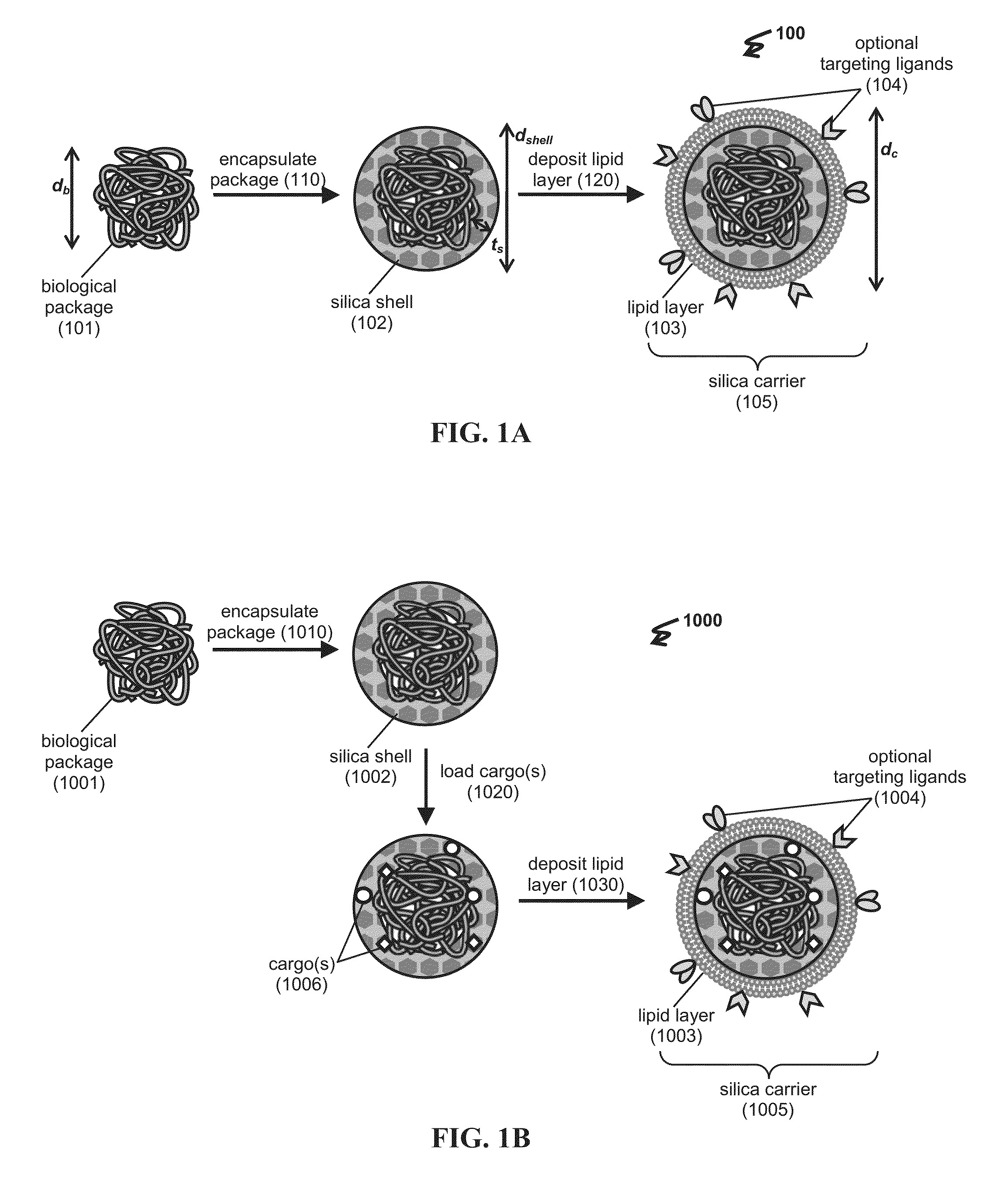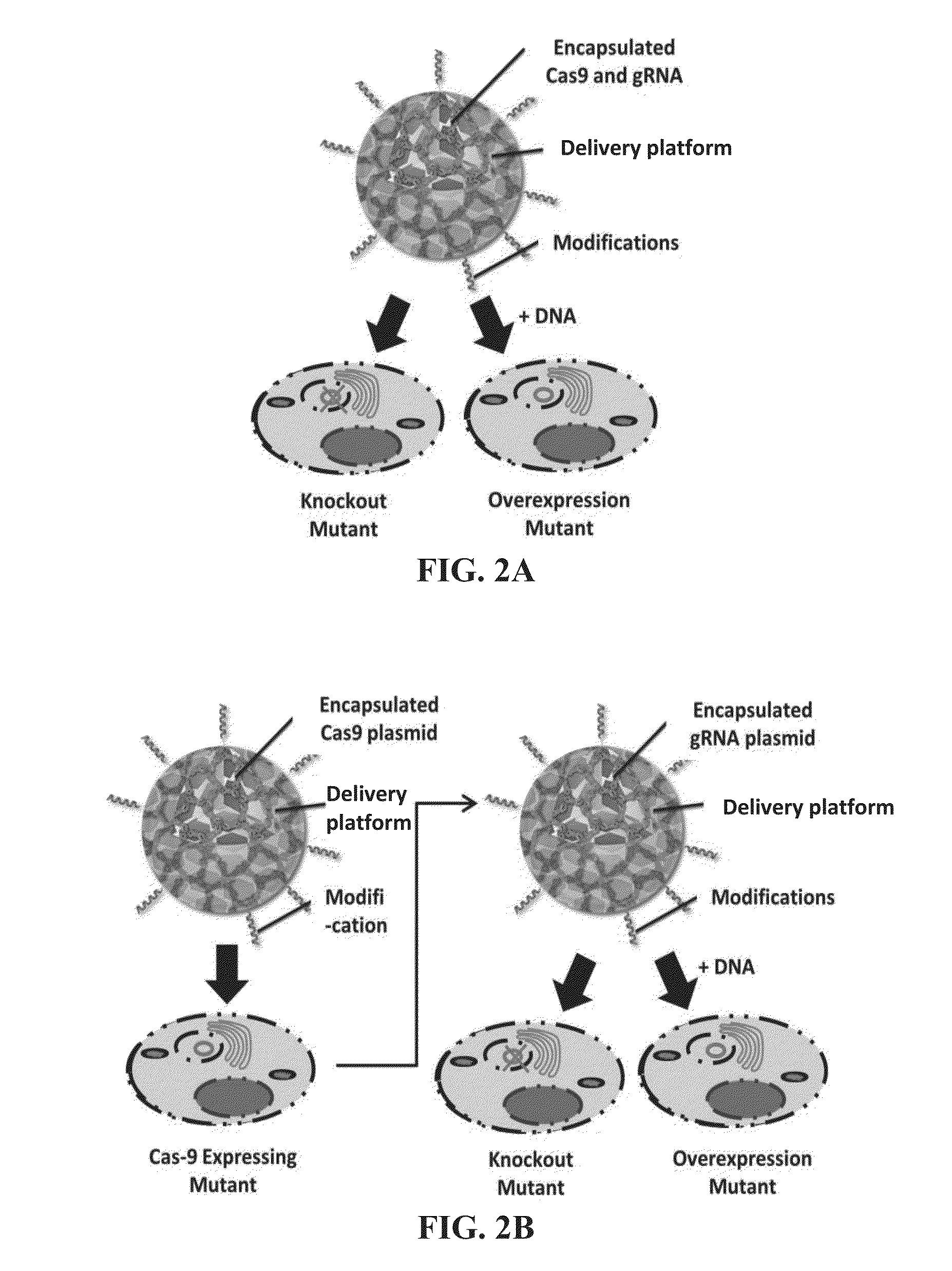Delivery platforms for the domestication of algae and plants
a technology for algae and plants, applied in the field of delivery platforms, can solve the problems of thwarting the delivery of genetic elements that can impart improved properties, unable to provide economically feasible fuel production for current algal productivities, etc., and achieve the effect of facilitating expression and enhancing the ability of histone-packaged plasmids
- Summary
- Abstract
- Description
- Claims
- Application Information
AI Technical Summary
Benefits of technology
Problems solved by technology
Method used
Image
Examples
example 1
Algal Targets
[0216]The NanoCRISPR delivery platform is widely applicable to any useful target that would benefit from exogenous genetic modification. For instance, the NanoCRISPR platform can be adapted to target industrially-relevant algal strains for biofuel applications. In another instance, the platform can be employed to genetically knock out proteins that are detrimental for efficient algal growth (e.g., use of a genomic target sequence (e.g., gRNA) that target and cleaves the DNA sequence encoding for an enzyme or cofactor that reduces algal growth).
[0217]Algal biofuels are promising candidates for renewable energy, yet current algal productivities must be improved by 2- to 5-fold to achieve the rates necessary for economically-feasible fuel production. However, algal cell walls are particularly recalcitrant, thwarting the delivery of DNA for genetic engineering efforts to improve productivity. As a result, only one model strain of algae, Chlamydomonas reinhardtii is currentl...
example 2
Nanoparticle Tools for the Domestication of Algae and Plants
[0219]Microalgae are ideal candidates as synthetic biology chasses for complex settings. These robust, photosynthetic microorganisms are capable of surviving under a range of environmental conditions and require minimal nutrients for growth (see, e.g., Rothschild L J et al., “Life in extreme environments,”Nature 2001; 409(6823): 1092-101). Despite these fundamental advantages, eukaryotic microalgae remain largely undomesticated due to transformation limitations associated with hardy algal cell walls and the lack of effective tools for targeted genetic modification (see, e.g., León-Bañares R et al., “Transgenic microalgae as green cell-factories,”Trends Biotechnol. 2004; 22(1):45-52). The platform herein can be employed to develop effective tools for the domestication of algae and plants.
[0220]We propose to develop tools for targeted genetic modification of eukaryotic microalgae by combining nanoparticle-mediated transformat...
example 3
Increasing Algal Production by Limiting Nighttime Loss of Biomass
[0234]In order for algal biofuels to become economically feasible, long term area1 production rates need to essentially double. Traditional efforts to improve algal productivities via bioprospecting and algal raceway design have failed to achieve the required improvements leading many to believe that genetic modification may be required. While the model alga, Chlamydomonas reinhardtii, can be easily manipulated, algae with biofuel potential have few tools if any for genetic modification. Therefore, we propose to develop genetic tools for an industrially-relevant alga, Nannochloropsis gaditana. The particle delivery system described herein can be applied for algal genetic transformation. This novel delivery method will be combined with recently-developed, eukaryotic genome editing technology to enable genetic manipulation.
[0235]To demonstrate the potential of these methods to improve production, we will target genes inv...
PUM
| Property | Measurement | Unit |
|---|---|---|
| Fraction | aaaaa | aaaaa |
| Thickness | aaaaa | aaaaa |
| Thickness | aaaaa | aaaaa |
Abstract
Description
Claims
Application Information
 Login to View More
Login to View More - R&D
- Intellectual Property
- Life Sciences
- Materials
- Tech Scout
- Unparalleled Data Quality
- Higher Quality Content
- 60% Fewer Hallucinations
Browse by: Latest US Patents, China's latest patents, Technical Efficacy Thesaurus, Application Domain, Technology Topic, Popular Technical Reports.
© 2025 PatSnap. All rights reserved.Legal|Privacy policy|Modern Slavery Act Transparency Statement|Sitemap|About US| Contact US: help@patsnap.com



